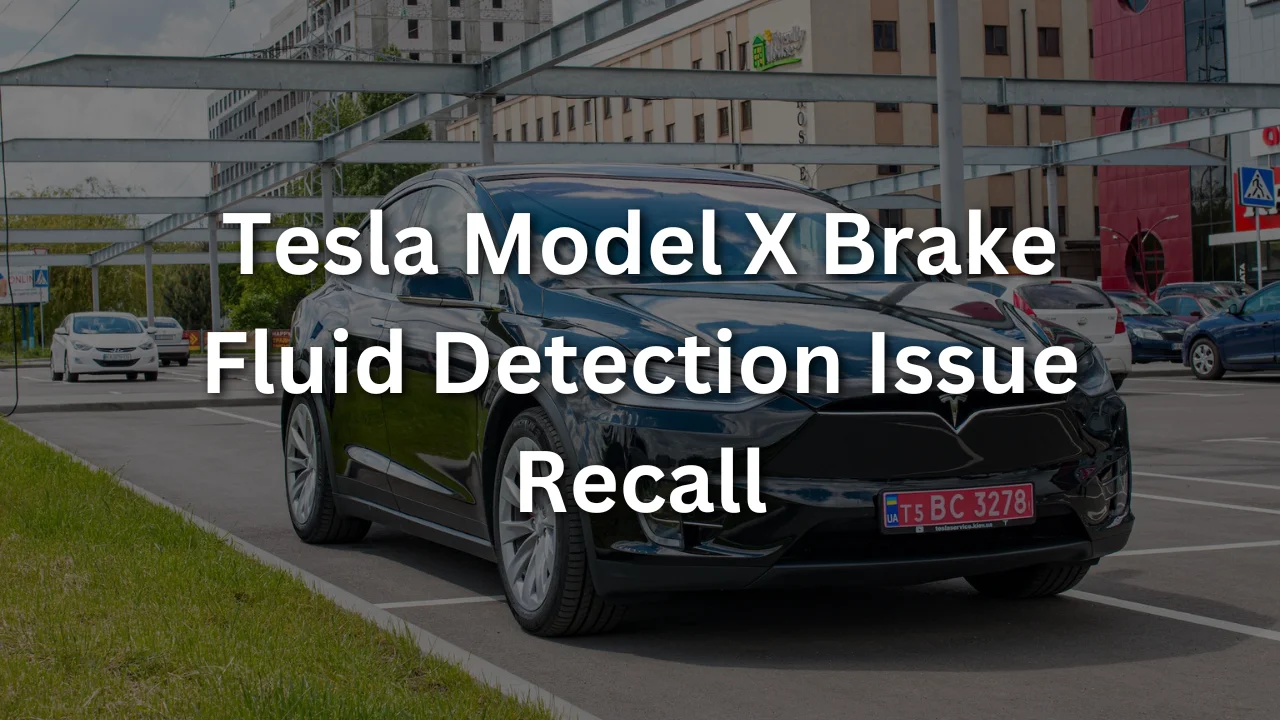Imagine cruising down the highway in your sleek and stylish Tesla Model X SUV, enjoying the thrill of emission-free driving. But wait, what if your vehicle suddenly fails to detect low brake fluid? That’s exactly what Tesla has discovered in nearly 55,000 Model X SUVs, prompting a recall to ensure the safety of its drivers. While Tesla has had a relatively recall-free year, this issue could potentially impact braking performance and increase the risk of a crash.
Don’t worry, though, because Tesla is taking action to resolve the problem by releasing an over-the-air software update. Starting on December 12th, owners will be notified of the recall, but in the meantime, they can reach out to Tesla or visit the National Highway Traffic Safety Administration’s website for more information. Drive worry-free with Tesla’s commitment to keeping you safe on the road.

Recall Details
Tesla has issued a recall for nearly 55,000 Model X SUVs due to a brake fluid detection issue. The affected vehicles are model-year 2021-23 Model X SUVs. The problem involves a vehicle controller that may fail to detect low brake fluid levels, which could potentially impact braking performance and increase the risk of a crash.
Affected Models
The recall affects model-year 2021-23 Model X SUVs.
Issue Description
The issue with the affected vehicles is related to the detection of low brake fluid levels. The vehicle controller may not accurately detect when the brake fluid levels are low, which can negatively impact the braking performance of the vehicle.
Brake Fluid Detection Problem
Brake fluid detection is an important feature in vehicles as it helps to monitor the level of brake fluid in the system. When the brake fluid levels are low, it indicates that there may be a leak or a problem with the braking system that needs to be addressed.
Impact on Braking Performance
The failure of the brake fluid detection system can have a significant impact on the braking performance of the affected vehicles. If the system fails to detect low brake fluid levels, it may not provide the necessary warnings or alerts to the driver. This can result in reduced braking power and an increased stopping distance, which can be dangerous and increase the risk of a crash.
Resolution: Over-the-Air Software Update
To resolve the brake fluid detection issue, Tesla has released an over-the-air software update. This update aims to address the problem with the vehicle controller and improve the accuracy of brake fluid detection in the affected vehicles. The software update can be installed remotely, eliminating the need for owners to visit a service center.
Notification to Owners
Tesla plans to begin notifying owners of the affected vehicles starting on December 12. The notification will inform owners about the recall and provide instructions on how to proceed. In the meantime, owners with further questions or concerns can contact Tesla at 877-798-3752. Tesla’s customer support team is available to assist with any inquiries related to this recall.
Contact Information
For more information about the recall, affected owners can contact Tesla at 877-798-3752. Additionally, the National Highway Traffic Safety Administration’s vehicle safety hotline can be reached at 888-327-4236 for further assistance. Owners can also visit Tesla’s website to check their vehicle identification number (VIN) and learn more about the recall.
What is a Brake Fluid Detection Issue?
Brake fluid detection is an essential feature in vehicles that helps to monitor the level of brake fluid in the system. It ensures that the braking system is operating at optimal levels and provides warnings or alerts when the brake fluid levels are low. The brake fluid detection issue in the recalled Model X SUVs involves a failure of the vehicle controller to accurately detect low brake fluid levels.
Explanation of Brake Fluid Detection
Brake fluid detection works by monitoring the level of brake fluid in the master cylinder reservoir. The master cylinder is responsible for distributing hydraulic pressure to the brakes to facilitate braking. When the brake fluid levels are low, it indicates that there may be a leak or a problem with the braking system that needs to be addressed.
Importance of Brake Fluid Detection
Brake fluid detection is crucial for the safe operation of vehicles. It ensures that the braking system is functioning properly and provides early warnings when there is a potential issue with the brake fluid levels. By detecting low brake fluid levels, it allows owners to address any problems with the braking system promptly, reducing the risk of accidents or failures while driving.
Consequences of Brake Fluid Detection Failure
The failure of the brake fluid detection system can have severe consequences for vehicle safety. If the system fails to detect low brake fluid levels, it may not provide the necessary warnings or alerts to the driver. This can result in reduced braking power, longer stopping distances, and an increased risk of a crash. It is essential to address any issues with brake fluid detection promptly to ensure the safe operation of the vehicle.
Recall Process
The recall process for the brake fluid detection issue in the affected Model X SUVs involved several steps, including testing, issue identification, and resolution. Tesla and the National Highway Traffic Safety Administration (NHTSA) played important roles in the recall process.
Brake Fluid Detection Testing
During the development and testing phase of the affected vehicles, Tesla conducted extensive testing of the brake fluid detection system. These tests aimed to ensure the accurate detection of low brake fluid levels and the reliable performance of the system.
Identification of the Issue
Through the testing process, Tesla identified a potential issue with the vehicle controller that could lead to the failure of brake fluid detection. The company recognized the importance of addressing this issue to ensure the safety of the affected vehicles and their drivers.
Resolution Process
To resolve the brake fluid detection issue, Tesla developed an over-the-air software update. This update aims to improve the accuracy and reliability of the brake fluid detection system by addressing the problem with the vehicle controller. The software update can be installed remotely, making it convenient for owners to receive the necessary fix.
Tesla’s Role
As the manufacturer of the affected vehicles, Tesla took responsibility for addressing the brake fluid detection issue. The company developed the necessary software update and initiated the recall process to ensure the safety of its customers.
National Highway Traffic Safety Administration’s Role
The NHTSA, as the regulatory body overseeing vehicle safety, played a role in monitoring and overseeing the recall process. The agency collaborated with Tesla to ensure that the necessary actions were taken to address the brake fluid detection issue.
Affected Vehicles
The recall affects model-year 2021-23 Model X SUVs. These vehicles are part of Tesla’s lineup of electric SUVs and have been identified as having the brake fluid detection issue.
Brake Fluid Detection Failure
The failure of the brake fluid detection system can have serious consequences for the safety of the affected vehicles and their occupants. It can lead to a risk of crashes and significantly impact the braking performance of the vehicles.
Risk of Crash
When the brake fluid detection system fails to accurately detect low brake fluid levels, it increases the risk of a crash. The driver may not receive the necessary warnings or alerts about the reduced braking performance, which can lead to accidents and collisions.
Impact on Braking Performance
The brake fluid detection failure can directly impact the braking performance of the affected vehicles. With reduced or insufficient brake fluid levels, the braking system may not operate at optimal levels, leading to longer stopping distances and potential loss of control in emergency braking situations.
Resolution
To address the brake fluid detection issue, Tesla has developed an over-the-air software update. This update aims to improve the accuracy and reliability of the brake fluid detection system in the affected vehicles.
Over-the-Air Software Update
The over-the-air software update developed by Tesla is a convenient way to deliver necessary fixes to the affected vehicles. Owners can receive the update remotely, eliminating the need to visit a service center.
Effectiveness of the Update
The over-the-air software update is designed to improve the accuracy and reliability of the brake fluid detection system in the affected Model X SUVs. Tesla has conducted extensive testing and evaluation to ensure the effectiveness of the update in addressing the issue.
Notification to Vehicle Owners
Tesla plans to begin notifying owners of the affected vehicles starting on December 12. The notifications will inform owners about the brake fluid detection issue and provide instructions on how to proceed.
Start Date of Notifications
The start date for the notifications to the vehicle owners is scheduled for December 12. Tesla will send out notifications to inform the owners about the brake fluid detection issue and the necessary steps to resolve it.
Methods of Communication
Tesla will communicate the recall information to the owners through various methods. These may include emails, phone calls, and postal mail. The company aims to ensure that the owners are aware of the recall and can take appropriate actions.
Tesla’s Contact Information
Owners with further questions or concerns about the recall can contact Tesla at 877-798-3752. Tesla’s customer support team is available to assist with any inquiries related to this recall.
National Highway Traffic Safety Administration’s Contact Information
For additional assistance or information, owners can contact the National Highway Traffic Safety Administration’s vehicle safety hotline at 888-327-4236. The hotline is available to provide support and answer any questions related to vehicle safety recalls.
Checking Vehicle Identification Number (VIN)
Owners can visit Tesla’s website to check their vehicle identification number (VIN) and learn more about the recall. This allows owners to confirm if their vehicle is affected and access specific information about the recall process.
Additional Information
For additional information about the recall and its resolution, owners can refer to Tesla’s website and the National Highway Traffic Safety Administration’s website. These sources provide comprehensive information about the recall process, resolution steps, and contact details for further inquiries.
Recall Process Details
The recall process for the brake fluid detection issue in the affected Model X SUVs involved comprehensive testing, cooperation with regulators, recall communication planning, and the service and repair process.
Testing and Evaluation
During the development and testing phase of the affected vehicles, Tesla conducted rigorous testing and evaluation of the brake fluid detection system. This ensured that the system operated as intended and accurately detected low brake fluid levels.
Cooperation with Regulators
Tesla cooperated with the National Highway Traffic Safety Administration (NHTSA) throughout the recall process. This collaboration ensured that the recall was initiated in a timely manner, and that the necessary steps were taken to address the brake fluid detection issue.
Recall Communication Plan
Tesla developed a comprehensive communication plan to notify affected vehicle owners about the recall. The plan included various methods of communication, such as emails, phone calls, and postal mail, to ensure that owners received the necessary information.
Service and Repair Process
Owners of the affected vehicles can receive the necessary service and repair at Tesla service centers. The over-the-air software update can be remotely installed to address the brake fluid detection issue, eliminating the need for owners to visit a service center.
Importance of Brake Fluid Detection
Brake fluid detection is crucial for the safe operation of vehicles and plays a significant role in the overall brake system safety.
Brake System Safety
The braking system is one of the most critical safety components in a vehicle. It allows drivers to slow down and stop their vehicles efficiently. Brake fluid detection ensures that the braking system is functioning properly and provides early warnings of any potential failures or issues.
Role of Brake Fluid
A brake fluid is a hydraulic fluid that transmits pressure within the braking system, allowing for the conversion of foot pressure on the brake pedal into stopping power. It plays a vital role in the proper functioning of the braking system.
Signs of Low Brake Fluid
Low brake fluid levels can be indicated by warning lights on the dashboard or a soft or spongy brake pedal. These signs may indicate a leak or a problem with the braking system that needs to be addressed promptly.
Contact Information
Owners with further questions or concerns can contact Tesla’s customer support number at 877-798-3752. For additional assistance, owners can also contact the National Highway Traffic Safety Administration’s vehicle safety hotline at 888-327-4236.
Tesla’s Website for Checking VIN
Owners can visit Tesla’s website to check their vehicle identification number (VIN) and learn more about the recall. This allows owners to confirm if their vehicle is affected by the brake fluid detection issue and access specific information about the recall process.
Additional Resources
For additional information and resources about vehicle recalls, owners can refer to Tesla’s website, the National Highway Traffic Safety Administration’s website, and other reputable automotive sources. These sources provide valuable information about vehicle safety, recalls, and maintenance.












